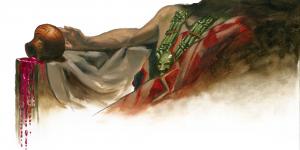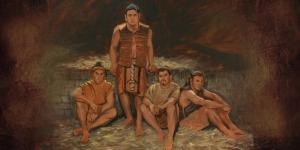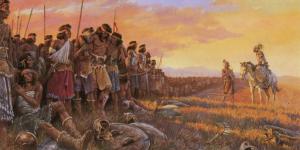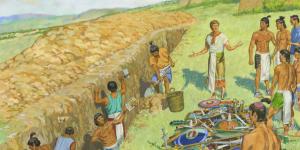You are here
Gospel Doctrine Lesson #32: They Did Obey Every Word of Command With Exactness

Scripture Block
Alma 53, 56-58
To help class members see that the Lord will strengthen them as they follow the example of Helaman’s valiant young soldiers.
Lesson Manual
KnoWhys

How Old Were the Stripling Warriors?
Alma 53:20
Articles
John A. Tvedtnes, “What Were the Ages of Helaman’s Stripling Warriors?,” Ensign, September 1992, 28.
Tvedtnes answers a question about the Stripling Warriors' ages by looking at Israelite war practices, and an analysis of the textual clues. Tvedntes concludes that the stripling warriors may have been from ages 21 to 26.
Stephen D. Ricks and William J. Hamblin, eds., Warfare in the Book of Mormon (Salt Lake City and Provo, UT: Deseret Book and FARMS, 1990).
This book published by the Maxwell institute covers a vast spectrum of topics on warfare in the Book of Mormon. Most of the wars in the Book of Mormon occur in what is often called the "war chapters" at the end of the book of Alma. This book contains contributing pieces ranging from weapons and armor to the spiritual application of military narratives.
Paul R. Cheesman, "Helaman 2 (Son of Alma the Younger)," in Encyclopedia of Mormonism, Daniel H. Ludlow, ed. Vol. 2. (New York: Macmillan, 1992).
A biographical entry for Helaman, the commander of the two-thousand stripling warriors.
Matthew L. Bowen, "“They Were Moved with Compassion” (Alma 27:4; 53:13): Toponymic Wordplay on Zarahemla and Jershon," Interpreter: A Journal of Mormon Scripture 18 (2016): 233-253.
Alma 53:10-13 utilizes a word play on the word "Zarahemla." It is argued that the etymology of the name "Zarahemla" is "seed of compassion" or "seed of pity." Thus, in Alma 53, when the text says "they were moved with compassion," the author is playing off of Zarahemla's name to create a clever pun.
Duane Boyce, "The Ammonites Were Not Pacificst," Interpreter: A Journal of Mormon Scripture 20 (2016): 293-313.
In providing context behind the parentage of the two-thousand stripling warriors, this article discusses how the Ammonites should not be considered pacifists, but rather fervent adherers to their sacred covenant with God.
John A. Tvedtnes, "Hebraisms in the Book of Mormon: A Preliminary Survey," BYU Studies, 11, no. 1 (1970): 50-58.
In "Hebraisms in the Book of Mormon: A Preliminary Survey," John A. Tvedtnes reminds us that the "The Book of Mormon, in its English form as provided by Joseph Smith, is in many respects a nearly literal translation...Indeed, in most cases thus far investigated, Book of Mormon expressions which are ungrammatical in English are perfect Hebrews grammar." These words, which are translated with exactness, can be obeyed with exactness.
Steven C. Walker, "More Than Meets the Eye: Concentration of the Book of Mormon," BYU Studies, 20, no. 2 (1980): 199-205
In this article Steven C. Walker warns us not to take the story of Helaman's stripling warriors lightly, despite the number of and it came to pass's. "The essence of Book of Mormon style is concentration." Far from being "wordy" or redundant, the Book of Mormon is highly focused on its purpose of showing God's dealings with man.
K. Douglas Bassett, "Nephi's Freedom Thesis 18 and the Sons of Helaman," in The Book of Mormon: Alma, the Testimony of the Word
Nephi's "Freedom Thesis" refers to his teaching that “Inasmuch as ye shall keep my commandments ye shall prosper in the land; but inasmuch as ye will not keep my commandments ye shall be cut off from my presence” (2 Nephi 1:20). In the war chapters of Alma 43–63, it is referred to, at least in principle, in every chapter. In fact, Mormon quotes Nephi’s thesis shortly before introducing the story of the stripling warriors. This article draws many correlations between the two and hypothesizes why Mormon would include it as a preface to a story of war.
Gerald Hansen Jr., "The Book of Alma as a Prototype for Teaching the Word of God," in The Book of Mormon: Alma, the Testimony of the Word.
An overview of the emphasis on the word of God in the book of Alma.
Additional Lesson Guides
LDS Living Gospel Doctrine Lesson #32
RSC Gospel Doctrine Lesson #32
Ben Spackman on Patheos: War Chapters Part I
Ben Spackman on Patheos: War Chapters Part II
GospelDoctrine.com Alma 53, Alma 56, Alma 57, Alma 58
Meridian Magazine Gospel Doctrine Lesson #32
Feast Upon the Word Lesson #32











